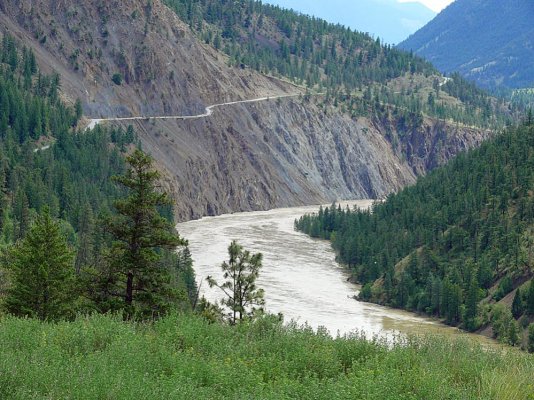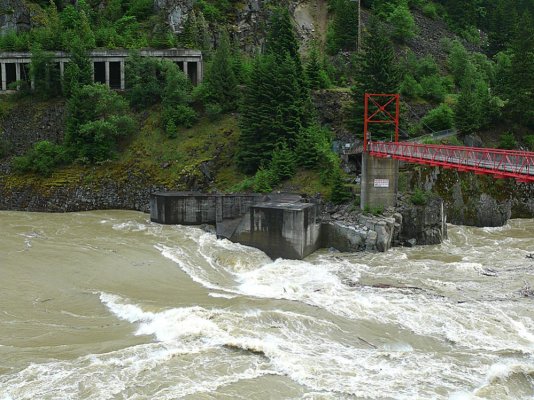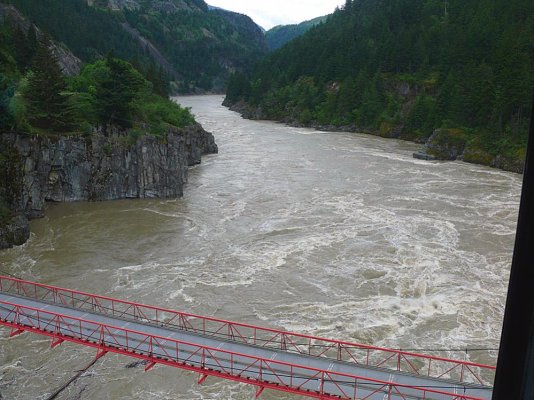Participants in this forum have heard those of us from the PNW talking about the debris in the water from Puget Sound north through BC and into SE Alaska. The debris ranges from logs, branches, and chunks of wood, to huge kelp and eelgrass mats, to man-made things like old pallets, boards, and crab trap floats and lines.
A major source of the logs, branches, and stumps we frequently encounter are the rivers that flow through the coast mountains to salt water. While they are too numerous to list here, in BC there are three really big ones: the Fraser, the Skeena, and the Stikine.
Over the three-day Memorial Day weekend this year, my wife and I took a road trip to a lake in the BC interior that we had not visited for some twenty years. The first part of the trip was up the Fraser and Thompson River canyons. On the way back I took my wife on the aerial tramway that goes from Canada's Highway 1 down to Hell's Gate on the Fraser.
The average flow volume of the Fraser at its mouth is over 122,000 cubic feet per second. At Hell's Gate (named by explorer Simon Fraser who had to negotiate the cliffs on jury-rigged scaffolding), the entire river channels through a narrow rock cut only 110 feet wide.
Five runs of salmon used to pass through Hell's Gate and on to their spawning grounds in the interior, but the construction of the railways on either side of the river canyon in the early 1900s caused rock slides that narrowed the gap even more.
The increased speed of the water was now too much for the salmon. Most of them battered themselves to death on the rocks as they tried to fight their way upriver, and the number of salmon reaching the interior plummeted to near extinction.
In the 1940s, a huge joint effort by the US and Canada saw the construction of massive fish ladders on either side of Hell's Gate. The salmon began to return to the interior spawning grounds and the recovery continues to this day.
I took these photos to give a bit of an idea of what the Fraser carries into the waters many of us up here boat in. The logs, branches, poles, and even entire trees complete with massive root balls flowed through Hell's Gate in an endless and constant procession. This same thing is occuring on the Skeena and the Stikine (a river I have flown numerous times), to say nothing of the lesser rivers and steams that enter salt water from the mountains.
The first photo of the river was taken on the backside of the Coast Range, where the environment is much drier than on the west, or raincoast side of the mountains. Even at its "normal" width, you can see that this a fiercely flowing river. The other photos were taken at Hell's Gate, in the Coast Range closer to the coast. The open-sided concrete structure in the trees above the high-water fish ladder in the second photo is a snow and rock shed over the mainline of the Canadian National railroad. The Canadian Pacific railroad is on the other side of the river.
Something we learned in the fish ladder museum there: a female salmon lays up to 7,500 eggs. From these 7,500 eggs, an average of nine salmon will survive to return to spawn.
A major source of the logs, branches, and stumps we frequently encounter are the rivers that flow through the coast mountains to salt water. While they are too numerous to list here, in BC there are three really big ones: the Fraser, the Skeena, and the Stikine.
Over the three-day Memorial Day weekend this year, my wife and I took a road trip to a lake in the BC interior that we had not visited for some twenty years. The first part of the trip was up the Fraser and Thompson River canyons. On the way back I took my wife on the aerial tramway that goes from Canada's Highway 1 down to Hell's Gate on the Fraser.
The average flow volume of the Fraser at its mouth is over 122,000 cubic feet per second. At Hell's Gate (named by explorer Simon Fraser who had to negotiate the cliffs on jury-rigged scaffolding), the entire river channels through a narrow rock cut only 110 feet wide.
Five runs of salmon used to pass through Hell's Gate and on to their spawning grounds in the interior, but the construction of the railways on either side of the river canyon in the early 1900s caused rock slides that narrowed the gap even more.
The increased speed of the water was now too much for the salmon. Most of them battered themselves to death on the rocks as they tried to fight their way upriver, and the number of salmon reaching the interior plummeted to near extinction.
In the 1940s, a huge joint effort by the US and Canada saw the construction of massive fish ladders on either side of Hell's Gate. The salmon began to return to the interior spawning grounds and the recovery continues to this day.
I took these photos to give a bit of an idea of what the Fraser carries into the waters many of us up here boat in. The logs, branches, poles, and even entire trees complete with massive root balls flowed through Hell's Gate in an endless and constant procession. This same thing is occuring on the Skeena and the Stikine (a river I have flown numerous times), to say nothing of the lesser rivers and steams that enter salt water from the mountains.
The first photo of the river was taken on the backside of the Coast Range, where the environment is much drier than on the west, or raincoast side of the mountains. Even at its "normal" width, you can see that this a fiercely flowing river. The other photos were taken at Hell's Gate, in the Coast Range closer to the coast. The open-sided concrete structure in the trees above the high-water fish ladder in the second photo is a snow and rock shed over the mainline of the Canadian National railroad. The Canadian Pacific railroad is on the other side of the river.
Something we learned in the fish ladder museum there: a female salmon lays up to 7,500 eggs. From these 7,500 eggs, an average of nine salmon will survive to return to spawn.




